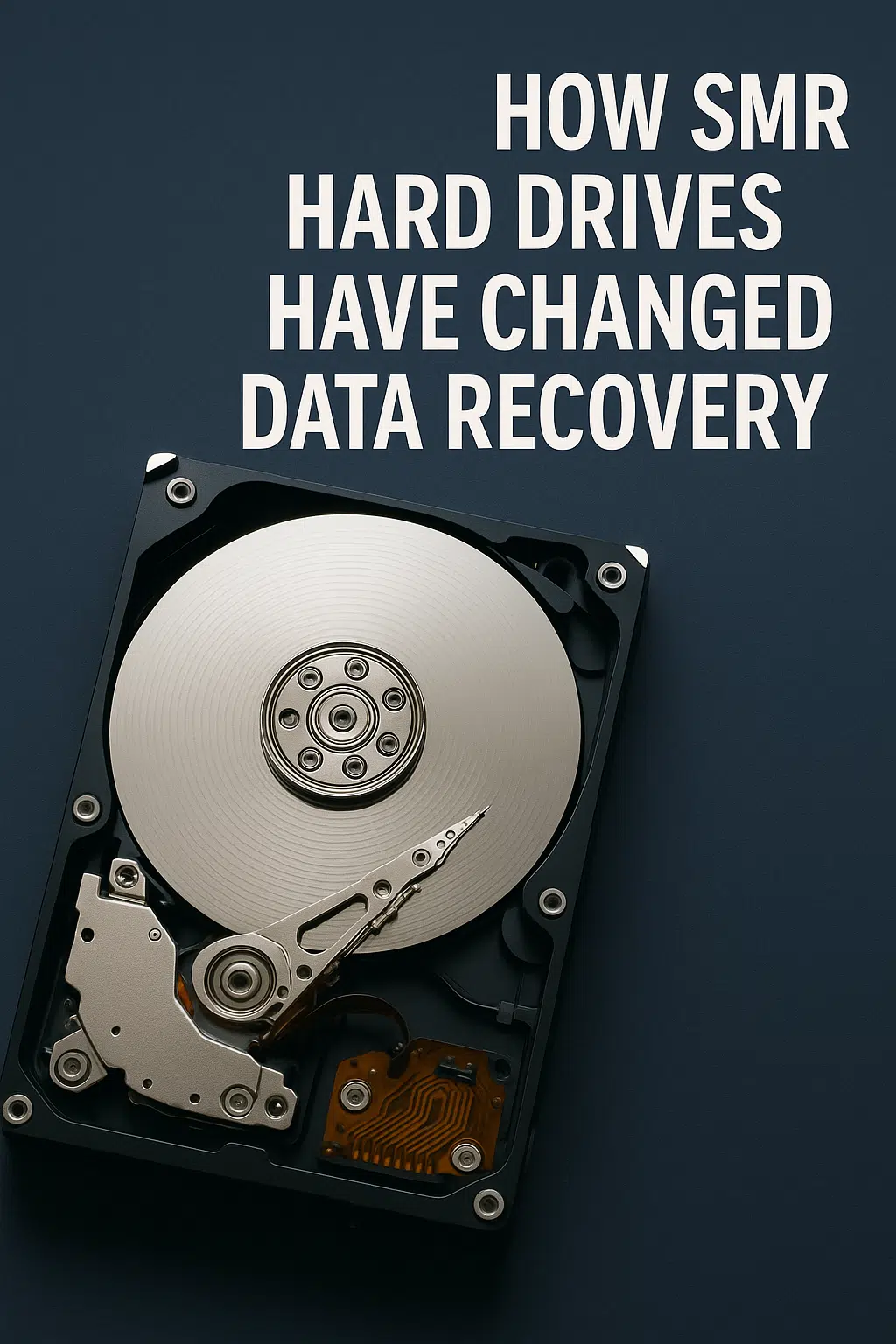Lost Data? How Seagate, WD, and Toshiba Drives Have Changed Data Recovery in Australia
2015: Simple Drives, Easier Fixes
In 2015, hard drives primarily used CMR (Conventional Magnetic Recording), a technology that stored data in separate tracks. Drives like the Seagate Barracuda ST1500DL003 (1.5TB) or Toshiba P300 HDWD130UZSVA (3TB) offered capacities up to 8TB.
If you accidentally deleted a file, recovery software could often retrieve it, provided new data hadn’t overwritten it. Even if the drive failed, it typically had fewer components—3 to 6 spinning discs—making repairs challenging but manageable for professionals.
2020: New Tech, Bigger Challenges
By 2020, SMR (Shingled Magnetic Recording) drives became more common. Models like the Western Digital Blue WD60EZAZ (6TB) and Toshiba DT02 HDWD240UZSVA (4TB) pushed capacities to 14TB by packing data more tightly.
These drives used helium to fit more discs (up to 8), reducing friction. However, SMR drives erase deleted files instantly, much like tearing up a letter, making recovery extremely difficult. Manufacturers also began encrypting the drive’s firmware, like a locked safe, to prevent tampering, further complicating repair efforts.
2025: Huge Drives, Complex Problems
Today, in 2025, advanced SMR drives dominate the market. Models like the Seagate Exos ST20000NM007D (20TB), Western Digital Ultrastar DC HC690 (32TB), and Toshiba MG11 (24TB) store massive amounts of data. These drives use 8 to 11 discs and powerful magnets to achieve such high capacities.
However, their fragility poses a challenge. A “head” crash—where a component strikes the discs—can destroy data. Repairs are difficult due to the strong magnets and increased disc count. Additionally, counterfeit drives from China have become a growing issue, with Seagate, Western Digital, and Toshiba using encrypted software to protect their technology, which further complicates recovery.
On SMR drives, deleted files vanish forever, unlike older CMR drives where recovery was often possible.
Old vs. New Drives: What’s Good and Bad?
Here’s a comparison of CMR and SMR drives:
- CMR (Older) Benefits: Fast performance, ideal for backups; deleted files often recoverable; easier to repair.
- CMR (Older) Drawbacks: Limited storage (up to 14TB in 2020); higher cost per GB.
- SMR (Newer) Benefits: Larger storage (20TB+); more cost-effective; energy-efficient.
- SMR (Newer) Drawbacks: Slower write speeds; deleted files unrecoverable; challenging to repair; not suited for heavy workloads.
Popular Hard Drives Today
Seagate, Western Digital, and Toshiba remain market leaders. Below are some popular models in 2025:
Seagate
- ST1500DL003 (Barracuda 7200.11, 1.5TB, CMR, older desktop)
- ST12000NE0008 (IronWolf Pro, 12TB, CMR, NAS)
- ST18000NM000J (Exos X18, 18TB, CMR, enterprise)
- ST8000DM004 (Barracuda, 8TB, SMR, desktop)
- ST20000NM007D (Exos X20, 20TB, SMR, enterprise)
Western Digital
- WD60EFRX (WD Red Plus, 6TB, CMR, NAS)
- WD181KFGX (WD Red Pro, 18TB, CMR, NAS)
- WD161KRYZ (WD Gold, 16TB, CMR, enterprise)
- WD60EZAZ (WD Blue, 6TB, SMR, desktop)
- Ultrastar DC HC690 (32TB, SMR, enterprise)
Toshiba
- HDWD130UZSVA (P300, 3TB, CMR, older desktop)
- HDWG480UZSVA (N300, 18TB, CMR, NAS)
- HDWD260UZSVA (P300, 6TB, SMR, desktop)
- HDWD240UZSVA (DT02, 4TB, SMR, desktop)
- MG11 (24TB, SMR, enterprise)
Always check with the manufacturer, as some models are available in both CMR and SMR variants.
How to Check If Your Drive Is SMR
Worried about lost files? SMR drives often erase data instantly. Here’s how to check if your drive uses SMR technology:
- Find Your Drive Model: Check the drive’s label or your computer settings for the model number. Visit Seagate, Western Digital, or Toshiba. If it says “SMR” or “Device-Managed SMR,” it’s an SMR drive. If it says “CMR” or “PMR,” it’s not.
- Use Software: Download CrystalDiskInfo (Windows). Look for “Zoned Device” or a large cache (256MB+), which suggests SMR.
- Ask the Manufacturer: Email the company with your model number if you’re unsure.
If your drive is SMR, deleted files are likely gone forever. If it’s CMR, you may have a chance to recover them. Stop using the drive immediately and contact data recovery professionals.
Why Choose Expert Help?
SMR drives are notoriously difficult to repair due to their encrypted software and instant data deletion. Payam Data Recovery, an Australian organisation with years of experience, uses specialised tools and cleanroom facilities to succeed where others fail.
Smaller companies often claim SMR drives can’t be fixed, but Payam’s high success rate—particularly on drives like the Seagate ST20000NM007D or Toshiba MG11—proves otherwise. Our expertise ensures your files have the best chance of recovery.
Specialised Recovery for SMR Drives
At Payam Data Recovery, we tackle the unique challenges of SMR drives using advanced tools like the PC-3000, specifically designed to handle SMR drives and their encrypted system areas. The PC-3000 allows us to back up and restore the T2 translator, a critical firmware component that maps data on SMR drives.
For instance, if a drive is formatted and shows all sectors as zeros, we can use PC-3000 to restore the original T2 translator, unhiding previously written data that might appear deleted. This process involves locking the user area to prevent further changes, ensuring we can recover your files safely.
We also employ advanced techniques for Western Digital USB external hard drives. Our engineers may solder a SATA port directly to the drive’s PCB to bypass USB encryption, allowing us to access the firmware area. Alternatively, we use specially designed unlocked PCBs, such as the WD 2060-810011 Data Recovery Unlock PCB from Dolphin Data Lab, to unlock the firmware without soldering. These methods enable us to back up key modules and recover data from even the most challenging SMR drives.
Need to recover data from an SMR drive? Contact Payam Data Recovery today for expert assistance.
Conclusion
Hard drives from Seagate, Western Digital, and Toshiba hold more data than ever, but losing files is a greater risk. Knowing your drive type and acting quickly can make all the difference. Contact Payam Data Recovery in Australia for expert help to recover your precious files.

